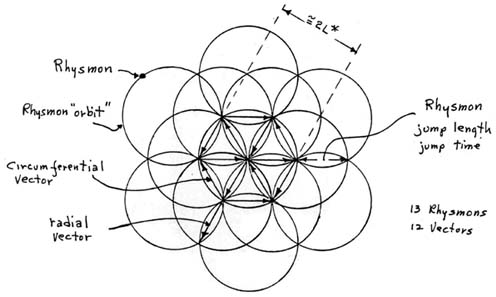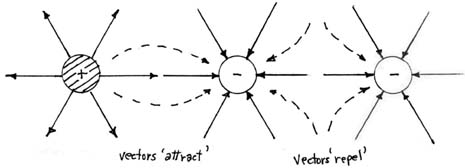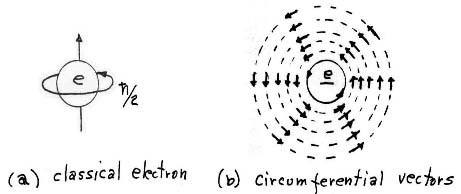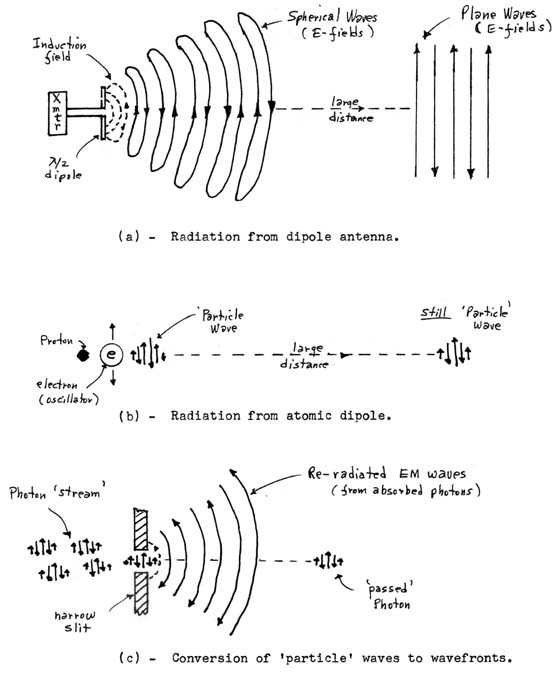The Nature of Electromagnetic Signal Propagation
by
Greg Hodowanec
Abstract
A simple mechanism for the propagation of electromagnetic waves, based upon the author’s ‘new’ cosmology, is briefly described. In essence, an updated version of the ‘aether’ theory is involved in this mechanism. Correlation between theory and experiment is shown to be good. Other potentials of the theory are also briefly mentioned.
Introduction
The use of electromagnetic radiation to transmit or receive impulses or signals without the use of connecting wires or waveguides is so common today that we now have many terms which were ‘coined’ to describe a particular aspect of these communication systems. For example, the term radio incorporates systems which involve sound broadcasting, be it in commercial, military, amateur, or citizen band applications. The term television incorporates vision broadcasting, which today, while using electromagnetic radiation signals, is also using guided signals, primarily cables. Another common term is radar where the systems employ electromagnetic radiation for the purpose of locating, identifying, or guiding fixed door moving objects. The reader is also aware of the many specialized applications such as garage door openers, intrusion alarms, wireless telephones, etc., as well as such sophisticated systems as those used in radio astronomy, for example. Therefore, with electromagnetic radiation signals so commonplace in our lives, perhaps the inquisitive reader or electronic experimenter has often wondered how exactly do these signals travel in space to reach us. It will be the purpose of this article to go beyond the usual (in simple fashion) of the actual basic mechanism underlying electromagnetic signal propagations.
History
Electromagnetic radiation ‘effects’ were probably noticed by many 19th century physicist and experimenters, notably Michael Faraday, theoretically predicted by James Clerk Maxwell, was finally conclusively generated and detected in the experiments of Heinrich Rudolf Hertz. Not much was done with these signals until Guliemo Marconi demonstrated in 1901 that long range communication using these signals was feasible. At this time the inquisitive and knowledgeable experimenter became involved and amateur radio as a hobby and avocation was born. These dedicated experimenters probably did more for the state-of-the-art of radio than any other group until the advent of World War II in 1939, when government and industry, out of necessity, teamed up to rapidly advance the state-of-the-art on all fronts. This effort was summarized in the well known MIT Radiation Laboratory Series of publications which were produced at the war’s end. While development work was continued since then, emphasis has been on the more practical aspects of communications rather than on studies of the basic mechanisms of electromagnetic wave propagation. This was the result of the theory of relativity and the new physics which did away with the classical view of an ‘aether’ which was hypothesized to be the ‘medium’ in which wave propagation took place. Failure to detect his medium in a number of tests was cause enough to drop this medium as an unnecessary assumption and reliance put on the mathematical descriptions of the propagation process. However, the author in some original work in physics and cosmology (Ref. 1), has come up with a new approach to the basics of electromagnetic radiation which, in essence, restores an updated version of the aether as the fundamental constituent of the ‘vacuum’. A substratum particle which he calls a ‘rhysmon’ forms the very fabric of the universe in a structure in which particles, fields, and forces are but different manifestations of this structure. Some of these concepts, which are essential to any discussion of the propagation process, will be briefly presented here. Further details will be found in the reference cited above.
Basic Rhysmonics
The substratum, or the new aether of the vacuum, is a storehouse of energy provided by the extremely small spherical ‘objects’ called the rhysmons. The rhysmons are contained within individual ‘orbits’ and have energy equal to one Planck Constant quantum of action, h. Individual rhysmons intertwine with other rhysmons in a matrix structure as shown in planar form inFigure (1). In this planar view it is seen that interweaving results in short directed rhysmonic vectors which now have energies of 2/h pi or h quantum of action. From this construction, one can define some additional parameters based on Planck’s Constant and his system of Natural Units (Ref. 2) There are further developed in Appendix I for reference. The complete matrix structure is shown in 3-dimensional form in Figure (2). This basic cell is reminiscent of R. Buckminster Fuller’s (Ref. 3) vector equilibrium I that all directed energy vectors in the pure rhysmoid, i.e., the undisturbed vacuum, cancel their energies and thus display no effects or phenomena which can be observable. The basic cell structures interlock with other cells to form the vacuum structure of the universe. This interlocking is depicted for an extended planar view in Figure (3). Shown are the directed vectors as given in the single instant of time given by Planck Time, T*. In the next instant of time, T*, all the vectors reverse direction and then restore to the original direction in time, T*. As seen in Figure (3), directed vectors join head-to-tail to form an ‘instantaneous’ vector which can span the universe. The instantaneous vectors are especially significant in the nature of gravitation. This simple interpretation of the structure of the universe forms the basis of rhysmonic cosmology (See Reference 1).
Figure 1: Complete planar view of balanced forces of vectors in basic cell of matrix structure

Figure 2: 3-Dimensional view of vector equilibrium of basic cell of matrix structure

Figure 3: Extended planar view of basic cell of matrix structure

Electric & Magnetic Fields
The cell structure depicted in Figure (1) and Figure (2) are for the vacuum state. Balance of forces in the vector equilibrium of the vacuum result in no phenomena, or effects, i.e., the vacuum is ‘unobservable’. For a ‘particle’ to be observed in the vacuum, the vacuum would have to be perturbated primarily as a change in density of the vacuum. This can be accomplished by a ‘tightened’ or a ‘loosened’ matrix structure of the form shown in Figure (2). A tightened matrix structure would result in an increased density of rhsymons compared to the vacuum, and as a result there would be an excess of directed rhysmonic vectors leaving such a region. The dense region would be said to have a ‘positive charge’ and the excess out directed vectors would form the flux field known as the positive electric field of this entity. Therefore, rhysmonics gives reality to the flux lines of charged particles as imagined by Faraday, Maxwell, and the other classicists of the 19th century. The depiction of charge and electric fields in rhysmonics, shown in Figure (4), is therefore pretty much as imagined by the classical physicists.
Figure 4: Rhysmonic charge & fields are the same as in classical fields

Figure 5: Depiction of the Rhysmonic Electron

It has been known since classical times that a moving charge will generate a magnetic field. This is because a particle which has charge, say an electron, in addition to a property called spin, has a new action called a magnetic moment. In rhsymonics, the electron is a ‘loosened’ spherical matrix structure in the vacuum, having a radius in the order of 10-13 cm and an angular momentum of h/2, as determined by the classicists. Rhysmonics has also shown the electric field between unlike charges to be the result of the flux of directed rhysmonic vectors moving between a region of excess (positive charge or a source) to a region of deficiency (negative charge or a sink) as was shown in Figure (4). Rhysmonics also shows that the magnetic field is due to an interaction of the excess vectors of the rotating charge region with the circumferential directed rhsymonic vectors surrounding the charge region as depicted in Figure (5). Here the electron is shown to be ‘spinning’ counterclockwise as it moves up and out of the paper. The excess directed vectors affect the circumferential vectors shown and thus cause a magnetic moment to be created. Thus the magnetic field is a closed loop of ‘rotating’ rhysmonic directed vectors, giving reality to the flux lines as imagined by faraday and the classicists, as well as that seen in the well known image formed by iron filings surrounding a current-carrying wire. Since the rhysmoncs are directed vectors, the flux line ‘flow’ is as was imagined by the classicists, i.e., that given by the right hand rule. From Figure (5) it can be shown (by Euclidian geometry) that the strength of the circumferential vectors, i.e., the magnetic field, will fall off inversely with the radius. The radial vectors, which formed the electric field flux lines, were shown to fall off inversely with the square of the radius. Thus, rhysmonics provides a logical explanation for the falling off of field strengths which have been determined from experiment.
Electromagnetic Fields
Rhysmonics has also shown that a translation of a ‘particle’ in the vacuum required a ‘spin’ for this process (See Ref. 1). However, if the particle has charge, i.e., excess directed vectors, the translation must be accompanied with an additional interaction with the circumferential vectors surrounding this charged particle, as was discussed above. This rotational energy forms the entity known as the magnetic field. Therefore, a dynamic translation of ‘charge’, i.e., an electric field, must of necessity also create a dynamic movement of circumferential vectors, i.e., a magnetic field. Thus, under dynamic conditions, we cannot speak of only an electric field or a magnetic field, but of a dynamic electromagnetic field. It can be shown that this process is reversible, i.e., a dynamic magnetic field, however created, must of necessity, also cause a translation of rhysmonic vectors, i.e., a movement of charge or an electric field. This is because the vacuum is a ‘perfect machine’ and the balance of forces requires these interactions (See Ref. 1).
Wave Propagation
A dynamic electromagnetic field has an additional interesting property in that the interacting fields result in a propagation effect in free space (the vacuum) which is known as an electromagnetic wave or EM radiation. A seldom-used illustration of this process is shown in Figure (6a). This is the ‘chain link’ interpretation of EM wave propagation. Here the fields are depicted as closed loop vectors for not only the magnetic component, but also the electric component. The H-field loops are shown lying in the plane of the paper, while the E-field loops are shown directed into the paper at (+) and coming out of the paper at (-), thus completing this loop. The direction of propagation is seen to be at right angles to both these components. This closed loop interpretation of wave propagation indicates a quarter wavelength or 90o phase shift between the electric and magnetic components, which is not indicated in most depictions of EM wave propagation. This may be a necessary requirement of the directed vector construction of the vacuum of the universe. The loops are shown as circular in this depiction for illustrative purposes only. It should be noted that the depiction is symmetrical, i.e., the E-components can be interchanged with the H-components, and vice versa, without affecting the nature of this propagation. This symmetry is also apparent in Maxwell’s equations.
When viewed under the substratum conditions of the rhysmonic matrix structure, this propagation process has some interesting consequences. As was seen in the planar view of circumferential vectors in the basic matrix structure of Figure (1), the closest approach of any two adjacent parallel directed rhysmonic vectors is approximately two times the Planck Length, L*, equal to about 3.2 x 10-33 centimeters. Since the magnetic component in electromagnetic propagation is at right angles to the direction of propagation, and since curl or a rotational vector geometry is also involved, magnetic field reversal as seen in the depiction of Figure (6a) cannot take place closer than this closest approach of parallel rhysmonic vectors, or 2L*. This concept is clarified in the simplified sketch of Figure (6b). Here the magnetic closed loop vectors (which are really the circumferential rhysmonic vectors) are shown, but the electric field vectors (which are really the radial rhysmonic vectors) are shown only by (+) where they enter the paper and (-) where they return out of the paper. Again, the magnetic rotational vectors cannot approach closer than the basic cell structure shown here. It should be noted that this basic cell could, in a broad sense, be considered as the ‘idler wheel’ imagined by Maxwell in is mechanical model of EM fields. Therefore, for each magnetic field reversal, i.e., each half wavelength of EM propagation, the wavelength must increase by this increment, 2L*, or 4L* per full wavelength. Since this increment is independent of wavelength, it is a linear factor and is also the observed Hubble Factor, but it should not be considered as a velocity factor. It should be remembered that E- and H-components may also be interchanged in this depiction. However, from symmetry, it is seen that the electric field component reversal also requires an increment of 4L* per wavelength. However, since both components are increased equally, the overall wave has a uniform expansion with wavelength of this same fixed amount of 4L*. Thus the longer EM waves travel in space, the more the wavelength increases. This process accounts for the so-called redshift in the spectra of distant galaxies.
Figure 6: Vector depictions for EM wave propagation

Velocity of Propagation
The vector depictions of Figure (6) are for EM propagation in the pure rhysmoid, i.e., the vacuum. Since the universe is like a cinema, with each frame in the cinema of existence lasting for Planck Time, T*, a rhysmonic field reversal, e.g., the magnetic field reversal, must occur only after a new frame has begum, i.e, after this time interval of T* has passed. But also in this time interval a rhsymonic vector has moved or ‘jumped’ a distance of Planck Length, L*. Therefore, the translation of these rhysmonic ‘effects’ is Planck Length, L*, in Planck Time, T*, which gives a Planck Velocity, C*, or as is calculated out, C, the known velocity of light (or EM waves) in the vacuum! Since repeated rhsymonic field reversals occur during the electric and magnetic field generations, as well as in this propagation process, the velocity of propagation must be this constant L*/T*, and is thus dependent of wavelength (frequency) or other factors such as initial velocity or energy. The only way the velocity of propagation would change is if L* and T* change. This is possible in ‘matter’ where the matrix structure is tightened or loosened, or under conditions where space and time are ‘dilated’ as per relativity theory.
Waves & Particles
The depiction of electromagnetic waves, thus far, has been on a fundamental mechanism basis. In practice, radio waves, in general, are initiated by antenna systems which are considerably larger than rhysmonic or atomic dimensions. Therefore, the overall radiative effects are definitely macroscopic in nature. For example, consider the simple dipole antenna system of Figure (7a). The linear dimensions of such an antenna are in the order of one half the wavelength of the generated EM wave. The radiation is initiated by an ‘induction’ field in the immediate region of the antenna, and is generally termed the ‘near field’. The radiated field is generated beyond about one wavelength in a delayed process due to the finite generation times for electric and magnetic fields. This mechanism may be found explained in most elementary texts on electromagnetic waves and will not be considered here. The important fact here is that the macroscopic nature of this wave generation results in an expanding spherical wave as depicted in Figure (7a). The electric component, in planar form, is shown as arcs of increasing length with distance from the antenna. At great distances, the radiation may be considered to be a plane wave, for all practical purposes. To be useful for information purposes, the wave is ‘modulated’ in some fashion, generally as pulse (code), amplitude (intensity), or as a frequency variation. In any event, these waves have all the characteristics of ‘waves’ as defined in classical physics.
Figure 7: Wave aspects of EM radiation

When the source of the radiation is from dipoles, say o atomic dimensions, the radiation will have different ‘characteristics’. Depicted in Figure (7b) is a simplified model of a hydrogen atom, which contains a single proton in the nucleus, and a single electron in ‘orbit’. When an energy change is made by the trapped electron, the sub-microscopic radiation released in this process is highly contained and may appear as depicted in Figure (7b). the highly localized fields now have the ‘characteristics’ of a localized ‘particle’, having both trapped energy and spin. This particle has been termed a photon and will exist as a short pulse of EM waves, perpetuated by the energy of the vacuum until dissipated in some fashion.
However, if a stream of such ‘particles’ is allowed to pass through a narrow slit, as shown in Figure (7c), the coherent nature of this radiation (it is all generated in the same manner) can introduce other effects due to absorption and re-radiation from the slit edges, to create an apparent wavefront, i.e., spherical and plane waves as depicted in Figure (7c). Therefore, EM waves generates at the atomic dimensions are generally ‘particle’ in nature, or photons, while macroscopic effects, generated by many photons, or large radiating structures, are generally recognized as waves. Thus particles and waves are but different aspects of rhysmonic effects in the vacuum. The smaller the wavelength, the more particle-like the effects.
Conclusions
A brief introduction on the nature of electromagnetic wave propagation from the viewpoint of the author’s rhsymonic cosmology has been presented. Even this brief glimpse has developed a number of concepts which will just be mentioned here:
1) The vacuum is a storehouse of potential energy and a perfect mechanical structure which under undisturbed conditions is unobservable. However, the energy of the vacuum can be found useful under certain conditions. Three simple examples are given here:
a) Electromagnetic wave propagation: This has been the main subject of this article. In essence, EM waves, once initiated, would be perpetuated forever by the intrinsic energy of the vacuum. In practice, matter in the universe would affect and dissipate this process. Even in pure vacuum, the energy would eventually ‘dissipate’ due to the increase in wavelength with tie of propagation.
b) Inertial effects: Although not emphasized here, inertial effects are also the result of the perfect mechanical nature of the structure of the vacuum. Again, once inertial effects are initiated, they would also be perpetuated forever by the intrinsic energy of the vacuum. Examples are astronomical objects, space satellites, and closer to home, the simple flywheel. Dissipation in the latter case is primarily due to resisting forces such as gas molecules and friction.
c) Magnetic fields: Since the magnetic field is a closed loop of rhysmonic energy, it should be possible, in principle, to ‘tap’ this energy and have it continuously replaced by the vacuum. Possibility of this approach has been partly confirmed by the author.
2) Nature of particles & fields: These are essentially perturbations of the pure vacuum. The important factor here is that the concepts of charges and fields, which were assumed by the classicists as aids in evaluating phenomena, are shown to have reality, i.e., these entities actually exist!
3) Velocity of light: The constant velocity of light (or EM waves) in the vacuum, which is only a postulate in relativity theory, is shown to be a necessary consequence in rhysmonics.
4) Redshift of spectra: The so-called expansion of the universe has been called upon to explain this phenomenon. Rhysmonics shows redshift to be but a function of the propagation process and universe expansion is not required.
5) Phase shift: Rhysmonic models appear to require a phase shift between the electric and magnetic components in EM wave propagation. This is not generally considered in most models of wave propagation.
Summary
The author hopes that the curiosity of the inquisitive and knowledgeable electronic experimenter as to the actual physical nature of ‘radio’ propagation has been answered, at least in part, by this article. However, the author believes that there is much more to intrigue the serious experimenter. As mentioned in the introduction, experimenters have contributed much to the development of early radio. The present day experimenter should find this ‘new’ cosmology very fertile ground for new concepts and innovations. These would have both practical and technical value, and the experimenter would have the satisfaction of exploring new and virgin territory. The author hopes that many would opt to do so.
References
1) G. Hodowanec: Rhysmonic Cosmology (1985).
2) Max Planck: The Theory of Heat Radiation, Dover, 1959.
3) R. Buckminster Fuller & R. Marks: The Dymaxion World of Buckminster Fuller; Doubleday Anchor Books, 1973.
Appendix I
Planck Units (also Rhysmonic Units):
H = Planck’s Constant ~ 6.624 x 10-27 erg-sec.
h = Planck’s Reduced Constant ~ 1.054 x 10-27 erg-sec.
L* = Planck’s Length ~ 1.616 x 10-33 cm.
T* = Planck’s Time ~ 5.391 x 10-44 sec.
C* = Planck’s Velocity ~ L*/T* = C ~ 2.997 x 1010 cm/sec
M* = Planck’s Mass ~ 2.177 x 10-5 gm.
L*3 = Planck’s Volume ~ 4.22 x 10-99 cm3.
D* = Planck’s Density ~ 5.157 x 1093 gm/cm3
Rhysmon Parameters:
Rhsymon radius ~ 1.62 x 10-66 cm.
Rhsymon volume ~ 1.78 x 10-197 cm3.
Rhsymon number ~ 2.37 x 1098 rhysmons/ cm3.
Derived Rhsymonic Units:
A* = action of rhysmon = h/2pi = h = E* x T* = E*/ f*
E* = energy of rhysmon = M* x C*2 = F* x L* = h /T*
F* = force of rhysmon = M* x a* = E*/ L*
f* = rhsymonic frequency = M* x a* = E*/L*
a* = rhysmonic acceleration = F*/M* = L*/T*2
Visible Universe Parameters:
Ro = radius ~ 1.14 x 1028 cm
Vo = volume ~ 6.2 x 1084 cm3
Mo = mass ~ 3.2 x 10178 gm
No = number of rhysmons ~ 1.47 x 10183
Eo = energy ~ 2.9 x 10199 ergs
Note: Some of the above determinations are only preliminary and these may be changed in the future.